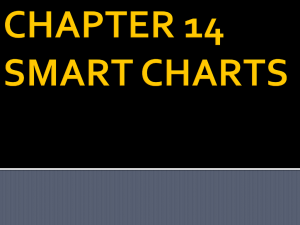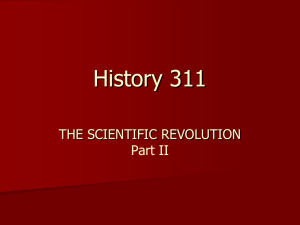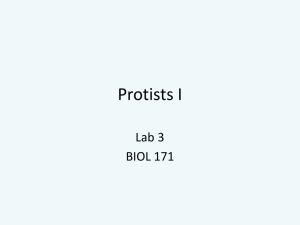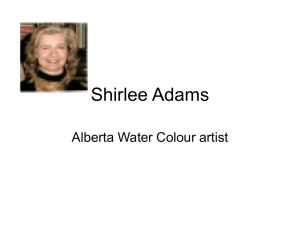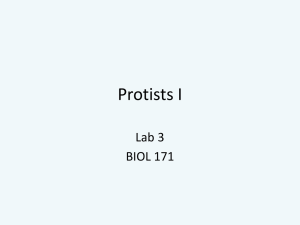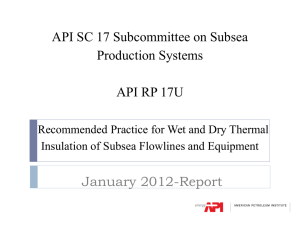Effects of Saline-Sodic Water Managment on Soil Chemical Properties
advertisement
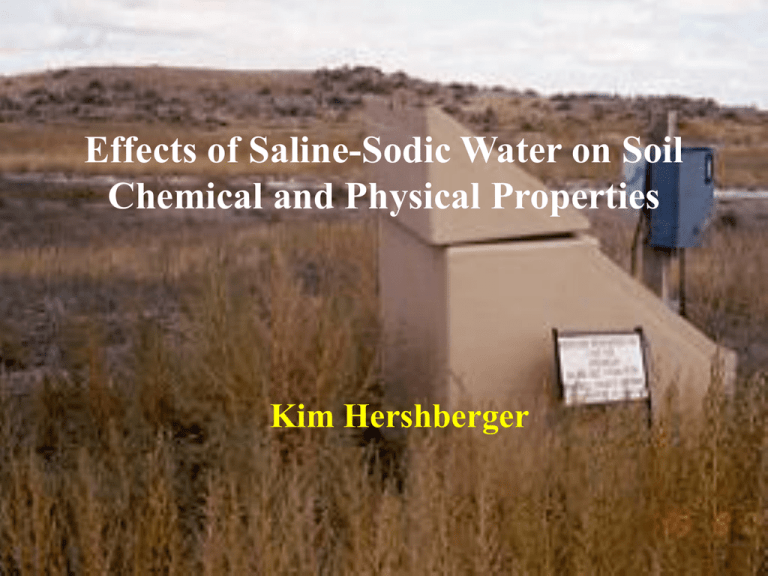
Effects of Saline-Sodic Water on Soil Chemical and Physical Properties Kim Hershberger My Study Assess the effects of modestly saline-sodic water on soil chemical and physical properties of selected soil materials. Overall Goal-Determine the suitability of irrigating with modestly saline-sodic waters, while still maintaining the sustainability of the soil. Two laboratory experiments which subjected soils of varying clay content to diverse wetting/drying regimes using two water qualities. Irrigable Acreages within the Buffalo Rapids Irrigation District Soil Series Taxonomy Texture Acres Cherry Fine-silty, mixed, frigid Typic Ustochrepts sicl 6052.4 Marias Fine, smectitic, frigid Chronic Haphsturts sic 3527.1 sicl 3045.3 fsl/l 2640.8 Spinekop Fine-loamy, mixed, superactive, frigid Aridic Haplustepts Trembles Coarse-loamy, mixed, calcareous, frigid Typic Ustifluvents Havre Busby Fine-loamy, mixed calcareous frigid Ustic Torifluvents Coarse-loamy, mixed Borollic Camborthids sil/sicl 2157.8 fsl 2002.1 TEXTURAL CLASSES 1- Clay % 0-11% - Loamy Sand, Sandy Loam, Loam 2- Clay % 12-22% - Sandy Loam, Loam, Silt Loam 3- Clay % 23-33% - Loam, Clay Loam, Silty Clay Loam 4- Clay % 34+ - Silty Clay Loam, Silty Clay, Clay Baseline Chemistry Data 18 16 14 Baseline EC, dS/m 12 Baseline SAR 10 Baseline ESP, % 8 6 4 2 0 4 6 7 8 9 15 17 18 19 21 21 22 23 26 28 29 30 33 33 34 37 44 45 52 56 Ranked Clay % Water Quality Targets POWDER RIVER EC = 1.56 dS/m SAR = 4.54 pH = 8.03 CBM (PRODUCT WATER) EC = 3.12 dS/m SAR = 13.09 pH = 8.22 Wetting Regimes 1X Wet/Dry with P.R. 1X Wet/Dry with CBM 5X Wet/Dry with P.R. 5X Wet/Dry with CBM 5X Wet/Dry with P.R. followed by leaching with 1 pore volume distilled water 5X Wet/Dry with CBM followed by leaching with 1 pore volume of distilled water Study of Soil Chemical Responses Treatment effect on soil chemistry was evaluated by monitoring the resultant saturated paste extract EC and SAR and comparing results with baseline conditions. Comparisons made by analyzing data based on their textural class. Methods Soil materials were saturated according to the water quality x wetting regime treatment combinations. 1X treatments-following wetting soils were oven dried. 5X treatments-intermediate drying cycles for 24 hours at 95 deg F; following fifth wetting soils were oven dried. For 5X+d, after fifth drying to 95 deg. F, soils were placed on wire mesh racks where ~1 pore volume of D.I. water was poured on the surface of each sample. Leachate water was allowed to drain for 24 hrs. Following drainage period, soils were oven dried. Resultant Mean Saturated Paste Extract EC and SAR for Textural Classes (across all treatments) Textural Class 1 2 3 4 n Mean EC (dS/m) + Mean SAR+ 9 13 16 11 3.08 a 3.39 a 3.28 a 3.78 b 6.06 a 6.04 a 5.34 a 7.91 b Resultant Mean Saturated Paste EC and SAR for Treatment Combinations (across all textures) Water Quality Treatment Base 1X P.R. 1X CBM 5X P.R. 5X P+d 5X CBM 5X C+d 49 49 49 49 49 49 49 Mean EC Mean SAR (dS/m) 0.82 a 2.56 a 1.51 b 5.94 b 2.46 c 3.92 b 3.21 d 4.94 b 3.02 e 4.86 b 6.93 f 11.31 c 5.73 g 10.85 c EC (dS/m) (saturated paste extract) 4 3.5 Baseline 1X Wet/Dry-P.R. 1X Wet/Dry-CBM 3 2.5 2 1.5 1 0.5 0 1 2 Textural Class 3 4 EC (dS/m) (saturated paste extract) Baseline 10 5X Wet/Dry-P.R. 9 5X Wet/Dry-CBM 8 7 6 5 4 3 2 1 0 1 2 Textural Class 3 4 EC (dS/m) (saturated paste extract) 12 Baseline 10 5X Wet/Dry-P.R. + distilled 5X Wet/Dry-CBM + distilled 8 6 4 2 0 1 2 Textural Class 3 4 SAR (saturated paste extract) 20 Baseline 18 1X Wet/Dry-P.R. 16 1X Wet/Dry-CBM 14 12 10 8 6 4 2 0 1 2 Textural Class 3 4 25 SAR (saturated paste extract) Baseline 20 5X Wet/Dry-P.R. 5X Wet/Dry-CBM 15 10 5 0 1 2 Textural Class 3 4 SAR (saturated paste extract) 30 Baseline 25 5X Wet/Dry-P.R. + distilled 5X Wet/Dry-CBM + distilled 20 15 10 5 0 1 2 Textural Class 3 4 35 30 ESP (%) = (1.18 x SAR) + 0.51 R2 = 0.94 ESP % (soil) 25 20 Baseline ESP = 15 1X Wet/Dry-P.R. 15 1X Wet/Dry-CBM 5X Wet/Dry-CBM SAR =12 10 5X Wet/Dry-CBM + Distilled 5X Wet/Dry-P.R. 5X Wet/Dry-P.R. + Distilled 5 0 0 5 10 15 SAR (soil solution) 20 25 30 30 Ayers and Westcot (1976) 25 SAR = 1.46 (EC) + 1.29 R2 = .54 SAR (soil) 20 Severe Reduction in Infiltration Slight to Moderate Reduction in Infiltration No Reduction in Infiltration 15 SAR = 12 10 Baseline 1X Wet/Dry-P.R. 1X Wet/Dry-CBM 5X Wet/Dry-CBM 5 5X Wet/Dry-CBM + Distilled 5X Wet/Dry-P.R. EC = 3 5X Wet/Dry-P.R. + Distilled 0 0 2 4 6 EC (dS/m) 8 10 12 Soil Chemistry Conclusions 1.Repeated irrigation with saline-sodic water will result in a general increase in the soil salinity and sodicity. 2.Repeated irrigation or dispersal of CBM product water to irrigable land is likely to result in elevated soil salinity levels substantially higher than published thresholds for some irrigated crops. 3. Soil solution salinity will equilibrate at an EC value approximately 2-3 times the EC of the applied water; soil solution SAR appears to equilibrate at a level comparable to the SAR of the applied water as long as leaching occurs. 4. Application of salt-free water following elevation of soil solution salinity and SAR through repeated wetting effectively reduced soil solution salinity while having little or no effect on sodicity. 5. The lowering impact of rainfall on EC and SAR is more predominant when salt concentrations are high, and in coarser-textured soils. 6. The greatest increases in EC and SAR upon wetting with either CBM or P.R. water were in coarsertextured soils. 7.In few instances of this study were soil solution salinity x sodicity combinations measured which exceed these thresholds following single wetting events. In essentially all instances where salinesodic water was repeatably applied, the resulting soil solution salinity and sodicity were significantly elevated to levels in close proximity to the previously published EC x SAR standards. 8. Results of this study appear to be consistent with previously published reports of the relationship between exchangeable sodium percentage (ESP) and solution SAR, i.e., SAR = 0.8 x ESP (approximately). Utilizing an ESP threshold of 15, the majority of treated soil samples exceeding this value resulted from alternate wetting regimes with CBM product water followed by simulated rainfall. Soil Physical Properties Study Methods Soil water retention was measured at 1/10 - 15 -bars of applied pressure. Water content was measured after soils had undergone treatment combinations (same as the soil chemistry study treatments. For 1X treatments, soils were saturated for 24 hrs before pressure was applied. For 5X treatments, soils were placed on wire racks for wet/dry cycles and transferred to pressure plates for the final wetting period. Methods cont. 5X+d-Same procedure as the 5X – Final wetting on the plate consisted of DI application Mean Gravimetric Water Content at Applied Pressure Potentials for each Textural Class (across all treatment combinations) Texture -1/10 bar -1/3 bar 1 0.25 a 0.11 a 2 0.33 b 0.21 b 3 0.39 c 0.28 c 4 0.45 d 0.32 d -1 bar 0.06 a 0.13 b 0.20 c 0.23 d -5 bar 0.05 a 0.10 b 0.15 c 0.18 d -15 bar 0.04 a 0.08 b 0.11 c 0.14 d Mean Gravimetric Water Content at Applied Pressure Potentials for each Treatment Combination (across all textures) WQ Treatment -1/3 bar 0.23 a -1 bar -5 bar -15 bar 1X P.R. -1/10 bar 0.37 a 0.16 a 0.12 a 0.09 a 1X CBM 5X P.R. 5X P+d 5X CBM 5X C+d 0.37 a 0.35 b 0.35 b 0.35 b 0.35 b 0.22 a 0.23 a 0.23 a 0.23 a 0.23 a 0.16 a 0.14 b 0.16 a 0.15 c 0.16 a 0.12 a 0.12 a 0.12 a 0.12 a 0.12 a 0.09 a 0.09 a 0.09 a 0.09 a 0.09 a Difference in Pw from Baseline (1X P.R.) g H2 0/g dry soil 0.2 0.15 0.1 1X Wet/Dry-CBM 1/10 (-bar) 5X Wet/Dry-PR 5X Wet/Dry-P.R. + distilled 5X Wet/Dry-CBM 5X Wet/Dry-CBM + distilled 0.05 0 -0.05 -0.1 -0.15 1 -0.2 2 3 Textural Class 4 Difference in Pw from Baseline (1X P.R.) g H 20/g dry soil 0.2 0.15 0.1 1X Wet/Dry-CBM 1/3 (-bar) 5X Wet/Dry-P.R. 5X Wet/Dry-P.R. + distilled 5X Wet/Dry-CBM 5X Wet/Dry-CBM + distilled 0.05 0 -0.05 -0.1 -0.15 1 2 3 -0.2 Textural Class 4 Difference in Pw from Baseline (1X P.R.) g H 20/ g dry soil 0.20 0.15 0.10 1X Wet/Dry-CBM 1 (-bar) 5X Wet/Dry-P.R. 5X Wet/Dry-P.R. + distilled 5X Wet/Dry-CBM 5X Wet/Dry-CBM + distilled 0.05 0.00 -0.05 -0.10 -0.15 1 -0.20 2 3 Textural Class 4 Difference in Pw from Baseline (1X P.R.) g H 20/g dry soil 0.20 0.15 1X Wet/Dry-CBM 5 (-bar) 5X Wet/Dry-P.R. 5X Wet/Dry-P.R. + distilled 0.10 5X Wet/Dry-CBM 5X Wet/Dry-CBM + distilled 0.05 0.00 -0.05 -0.10 -0.15 1 -0.20 2 3 Textural Class 4 Difference in Pw from Baseline (1X P.R.) g H20/g dry soil 0.20 1X Wet/Dry-CBM 15 (-bar) 5X Wet/Dry-P.R. 0.15 5X Wet/Dry-P.R. + distilled 5X Wet/Dry-CBM 0.10 5X Wet/Dry-CBM + distilled 0.05 0.00 -0.05 -0.10 -0.15 1 -0.20 2 3 Textural Class 4 Textural Class #1 0.4 Water Content (g H20/g drysoil) 0.35 1X Wet/Dry-P.R. 0.3 1X Wet/Dry-CBM 5X Wet/Dry-P.R. 0.25 5X Wet/Dry-P.R. + distilled 0.2 5X Wet/Dry-CBM 0.15 5X Wet/Dry-CBM + distilled 0.1 0.05 0 0 2 4 6 8 10 12 14 Matric Potential (h) (-bars) Textural Class #2 1X Wet/Dry-P.R. 0.6 Water Content (g H 20/g dry soil) 1X Wet/Dry-CBM 0.5 5X Wet/Dry-P.R. 0.4 5X Wet/Dry-P.R. + distilled 0.3 5X Wet/Dry-CBM 0.2 5X Wet/Dry-CBM + distilled 0.1 0 0 2 4 6 8 10 Matric Potential (h) (- bars) 12 14 Textural Class #3 1X Wet/Dry-P.R. Water Content (g H 20/g dry soil) 0.6 1X Wet/Dry-CBM 5X Wet/Dry-P.R. 0.5 5X Wet/Dry-P.R. + distilled 0.4 5X Wet/Dry-CBM 5X Wet/Dry-CBM + distilled 0.3 0.2 0.1 0 0 5 10 15 Matric Potential (h) (-bars) Water Content (g H 20/g dry soil) Textural Class #4 0.7 1X Wet/Dry-P.R. 0.6 1X Wet/Dry-CBM 0.5 5X Wet/Dry-P.R. 5X Wet/Dry-P.R. + distilled 0.4 5X Wet/Dry-CBM 0.3 5X Wet/Dry-CBM + distilled 0.2 0.1 0 0 5 10 Matric Potential (h) (-bars) 15 Soil Physical Properties Conclusions 1. Water content associated with matric potential differed significantly due to predominant soil texture at all matric potentials investigated in this study. 2. Significant differences in water holding capacity of coarser-textured soils occur due to water quality treatment more often at greater matric potentials. In finer-textured soils differences in water holding capacity due to water quality treatment are more likely to occur at lower potentials. 3. Significant changes in water holding capacity due to water quality treatment are only on the order of 0.02-0.04 g H20/g dry soil. The change reflected a decrease in water holding capacity in textural classes 1 & 2 and an increase in water holding capacity in textural class 3. 4. Reductions in water retention in coarser-textured soils are attributable to the loss of large pore spaces. 5. The addition of saline-sodic water had the greatest effect on soil physical properties when the soil is near saturation. Changes in water holding capacity are likely to have non-discernible impact on irrigation suitability. 6. Successive wetting/drying cycles can cause aggregate coalescence and the loss of interaggregate porosity; this appeared to occur more often in the coarser-textured soils. 7. Although statistically significant differences were detected among water quality treatments, differences were not large enough to have a significant ecological impact. 8. CBM product water applied at these levels did not have a consistent significant impact on soil physical properties, i.e., water-holding capacity. Acknowledgements ACKNOWLEDGEMENTS Committee: Dr. Jim Bauder (chair), Dr. Douglas Dollhopf, Dr. Jon Wraith Funding: Prairie County Conservation District, Buffalo Rapids Irrigation District, Department of Energy Bernard Schaff, Susan Winking, and Bauder Students
